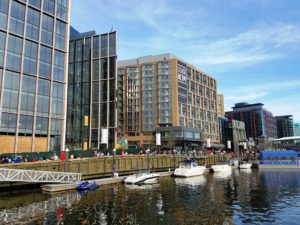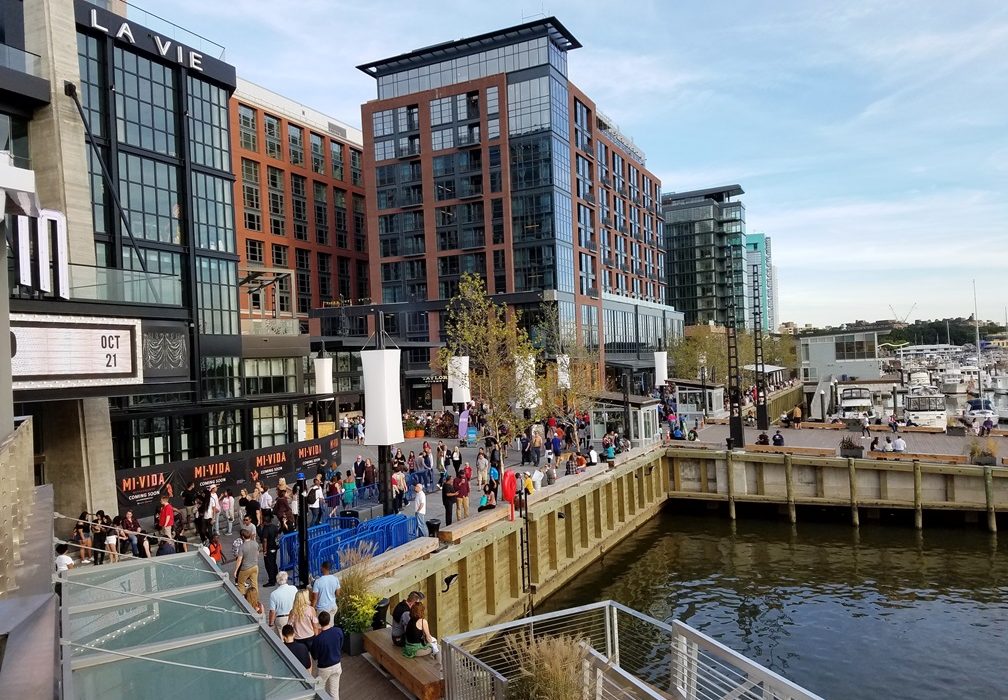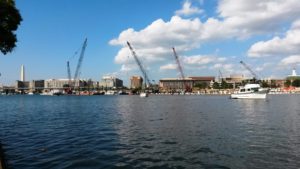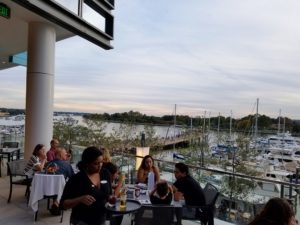At a cost of $2.5 billion, the Wharf (along the Southwest waterfront of Washington, DC) is one of the most aggressive efforts in recent memory by the District of Columbia, maybe by any city, to reinvent a waterfront.
When the second phase is completed in 2022, there will be a mile of waterfront on 24 acres of land, 50 acres of riparian rights in the channel, 1,375 residences, 945,000 square feet of office space, 800 rooms in four hotels, 2,500 parking spaces, and 10 acres of parks and open spaces.
It also happens to be located near the site of a previous, infamous attempt at urban transformation: In the 1950s, the federal and local governments leveled thousands of buildings in Southwest and forced 4,500 mostly poor African Americans to move. They then built a mass of brutalist-style housing complexes around a retail center, Waterside Mall.
John King, the San Francisco Chronicle‘s longtime urban design critic who studied in Washington for much of this year, has a term for the mega real estate projects that big-money developers assemble under the banner of placemaking: “instant urbanism.” It’s often applied to town-center-style developments in the suburbs — as a pejorative for their soulless, cookie-cutter design. He counts the Wharf as an example of this phenomenon.

Monty Hoffman’s (the Wharf’s creator) development company says the first phase of the Wharf has 200 out of a total of 649 rental units offered at below-market rates. (That figure does not include condos being sold at market rates.) The units are awarded by lottery. The idea is to help low- and middle-income residents, as required by the city.
But in reality, these units remain unattainable for a large swath of residents. For instance, a household of three earning between $60,000 and $99,000 would pay $2,481.75 a month for a two-bedroom.
Kathryn Howell, an assistant professor at Virginia Commonwealth University who has studied publicly subsidized development in the District, calls the Wharf an epic missed opportunity to use city-owned land to require more affordable housing. “They gave the store away,” she says — and now that the opportunity is gone, it is even more imperative for the city to ensure residents in nearby Section 8 and public housing projects such as Greenleaf Gardens and James Creek will be able to remain.
He explained to me one more time why he stuck with this project, through his partner’s bankruptcy, a global search for capital and a seemingly endless wait for government approvals: to have a hand in reconnecting Washington to its waterfront. “This will always be the nation’s capital,” he said. “But it is a waterfront city, and time will tell whether it will be viewed that way.”
My Take:
As a long-time local resident of the DC area, I (Storm Cunningham) have mixed feelings about the Wharf. On balance, I lean towards the positive, if for no other reason than the fact that the Southwest waterfront was such a dysfunctional mess before it came along. When the bar is set that low, one can’t help but succeed.
That said, the designer and redeveloper did a better-than-average job, by the “new urbanist” principles to which they subscribe. In too many case, new urbanist developments are sterile and hyper-commercial. In sprawl settings, the pedestrian-friendliness of the approach is used as a marketing tool to justify greenfield developments.
In urban settings, new urbanism tends to be a modern version on the old “urban renewal” approach: clear away everything that’s old. The two big differences from urban renewal are 1) walkable design, and 2) the demolition is immediately replaced with new structures (the urban renewal model merely demolished: it trusted market forces to fill in the urban voids, which failed to happen in the vast majority of cases).
In the Wharf’s case, that Disneyland-like sterility is certainly there, but it’s ameliorated by the magic of the water, the park view across the water, and what’s left of the real neighborhoods on the back side.
The jitney across the water to Potomac Park is a nice idea, but poorly managed. On our most recent weekend visit in June, the jitney wasn’t running, and there was no sign on the dock on the park side warning people. So many dozens of people waited on the dock in 95-degree heat in vain, coming away with a very negative impression of the Wharf.
Maybe the most brilliant decision made by the city and the redeveloper was retaining the funky old fish market. That adds a heritage dimension that the Wharf desperately needs. Normally, urban planners would have wiped that slate clean, as they tried to do with the Old post Office, the most beautiful building in the downtown. Planners wanted to demolish it because it didn’t fit The Sacred Plan for the Federal Triangle area’s design. Fortunately, sanity prevailed and the planners were thwarted.
All photos are by Storm Cunningham.



